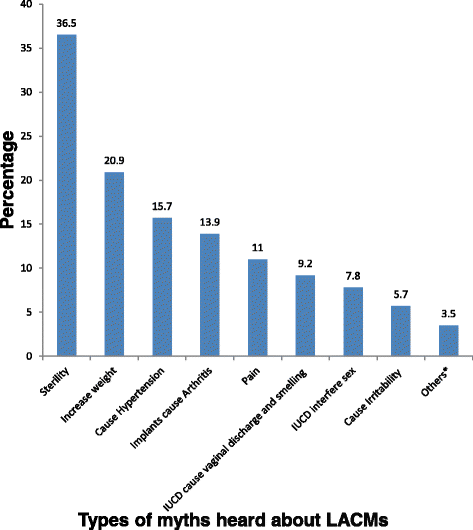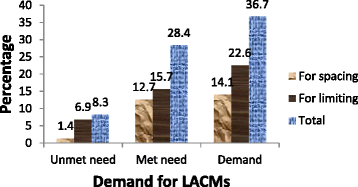Demand for long acting contraceptive methods among married HIV positive women attending care at public health facilities at Bahir Dar City, Northwest Ethiopia
- PMID: 26311141
- PMCID: PMC4551468
- DOI: 10.1186/s12978-015-0073-0
Demand for long acting contraceptive methods among married HIV positive women attending care at public health facilities at Bahir Dar City, Northwest Ethiopia
Abstract
Background: The use of long acting contraceptive methods (LACMs) is one of the strategies for preventing mother-to-child transmission (MTCT) of HIV. Studies noted that significant proportion of unintended pregnancy among HIV positive women was due to contraceptive failure mainly of short term contraceptives. This highlights the need to use most effective types of modern contraception, long acting contraceptive. However, studies conducted on demand for long acting contraceptive methods in this particular group of people are scarce in Ethiopia. This study aimed to assess demand for long acting contraceptive methods and associated factors among married reproductive age women attending care at Antiretroviral treatment (ART) clinics in public health institutions at Bahir Dar City, Northwest Ethiopia.
Methods: Institution-based cross-sectional study was conducted among 654 systematically selected women attending care in ART clinics in public health facilities at Bahir Dar city from March to April, 2014. A structured and pretested interviewer administered questionnaire was used to collect data. Data were entered using EPI info version 3.5.3 and then exported to SPSS version 16 for analysis. Descriptive statistics were used to describe the socio-demographic and economic characteristics of the study participants. Logistic regression analyses were employed to identify factors associated with demand for long acting contraceptive methods. Odds ratios with 95 % CI were used to assess the presence and strength of association.
Results: A total of 654 respondents have participated in the study (response rate 99. 09 %). The demand for long acting contraceptive methods was 36.7 % (95 % CI: 33.2 %, 40.6 %). The odds of demand for LACMs among HIV positive women who were living in urban were three times [AOR = 3.05, 95 % CI: 1.34, 6.89] higher than those who were living in rural. The odds of demand for LACMs among the respondents who were in elementary educational level were two times [AOR = 2.31, 95 % CI: 1.34, 3.99] more likely as compared to those who had no formal education. HIV positive women who had four or more alive children were almost four times [AOR = 3.86, 95 % CI: 1.62, 9.20] more likely to have demand for LACMs than those who had one child or had no child at all. Those who had desire to give birth after 2 years were nearly six times more likely [AOR = 5.68, 95 % CI: 3.05, 11.58] to have demand for LACMs and women who had no birth intension were eight times more likely [AOR = 7.78, 95 % CI: 4.15, 14.58] to have demand for LACMs as compared to those who had intention to have birth within 2 years. Women who had past experience on LACMs had six times more likely [AOR = 6.35, 95 % CI: 4.09, 9.87] to have demand for LACMs than those who hadn't any experience. The odds of demand for long acting contraceptive methods among HIV positive women who had heard myths about LACMs was 55 % less [AOR = 0.45, 95 % CI: 0.29, 0.68] than those women who hadn't heard myths.
Conclusions: Demand for long acting contraceptive methods in this study was low. There was high unmet need for LACMs. Myths about LACMs were common in the community and were the major barriers for the promotion and utilization of the methods. Demand creation on LACMs and bringing attitudinal change related to myths through provision of information, education and communication are recommended. Moreover, giving greater attention for rural residents is important.
Figures


Similar articles
-
Demand for long acting contraceptive methods and associated factors among family planning service users, Northwest Ethiopia: a health facility based cross sectional study.BMC Res Notes. 2015 Feb 4;8:29. doi: 10.1186/s13104-015-0974-6. BMC Res Notes. 2015. PMID: 25656470 Free PMC article.
-
Associated factors of modern contraceptive use among women infected with human immunodeficiency virus in Enemay District, Northwest Ethiopia: a facility-based cross-sectional study.BMC Public Health. 2019 Nov 28;19(1):1584. doi: 10.1186/s12889-019-7675-3. BMC Public Health. 2019. PMID: 31779605 Free PMC article.
-
Factors affecting long acting and permanent contraceptive methods utilization among HIV positive married women attending care at ART clinics in Northwest Ethiopia.Arch Public Health. 2018 Jul 16;76:47. doi: 10.1186/s13690-018-0294-0. eCollection 2018. Arch Public Health. 2018. PMID: 30026946 Free PMC article.
-
Utilization of modern contraception and determinants among HIV positive women in Ethiopia: a systematic review and meta-analysis.BMC Womens Health. 2024 Nov 20;24(1):616. doi: 10.1186/s12905-024-03454-9. BMC Womens Health. 2024. PMID: 39567937 Free PMC article.
-
Contraceptive Use and Method Preferences among HIV Positive Women in Ethiopia: A Systematic Review and Meta-analysis.Biomed Res Int. 2020 Sep 18;2020:6465242. doi: 10.1155/2020/6465242. eCollection 2020. Biomed Res Int. 2020. PMID: 33015174 Free PMC article.
Cited by
-
Prevalence of long-acting reversible contraceptive methods utilization and associated factors among counseled mothers in immediate postpartum period at Jimma University medical center, Ethiopia.Contracept Reprod Med. 2022 Sep 2;7(1):17. doi: 10.1186/s40834-022-00184-x. Contracept Reprod Med. 2022. PMID: 36050794 Free PMC article.
-
Knowledge and practice of health extension workers on drug provision for childhood illness in west Gojjam, Amhara, Northwest Ethiopia.BMC Public Health. 2020 Apr 15;20(1):496. doi: 10.1186/s12889-020-08602-y. BMC Public Health. 2020. PMID: 32295548 Free PMC article.
-
Unmet need for family planning among reproductive-age women living with HIV in Ethiopia: A systematic review and meta-analysis.PLoS One. 2021 Aug 2;16(8):e0255566. doi: 10.1371/journal.pone.0255566. eCollection 2021. PLoS One. 2021. PMID: 34339464 Free PMC article.
-
Determinants of long acting contraceptive utilization among HIV positive reproductive age women attending care at art clinics of public health facilities in Arba Minch town, Southern Ethiopia, 2019: a case control study.AIDS Res Ther. 2020 Jun 15;17(1):34. doi: 10.1186/s12981-020-00288-x. AIDS Res Ther. 2020. PMID: 32539743 Free PMC article.
-
Utilization of Immediate Postpartum Long Acting Reversible Contraceptives among Women Who Gave Birth in Public Health Facilities in Eastern Ethiopia: A Cross-Sectional Study.Int J Reprod Med. 2021 Nov 10;2021:1307305. doi: 10.1155/2021/1307305. eCollection 2021. Int J Reprod Med. 2021. PMID: 34805394 Free PMC article.
References
-
- Oni EE, Ross A, Van der Linde S. Contraceptive practices amongst HIV-positive women on antiretroviral therapy attending an ART clinic in South Africa. Afr J Prm Health Care Fam Med. 2013;461(5):1.
-
- UNAIDS . Report on the global AIDS epidemic, UNAIDS fact sheet. 2014.
-
- WHO . Global health sector strategy on HIV/AIDS 2011–2015. 2011.
-
- UNAIDS . GLOBAL REPORT: UNAIDS report on the global AIDS epidemic. 2013.
MeSH terms
LinkOut - more resources
Full Text Sources
Other Literature Sources
Medical
Miscellaneous

